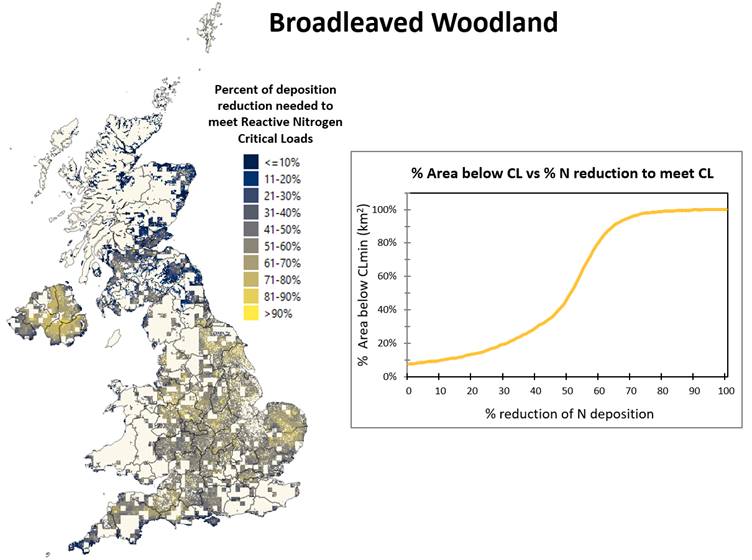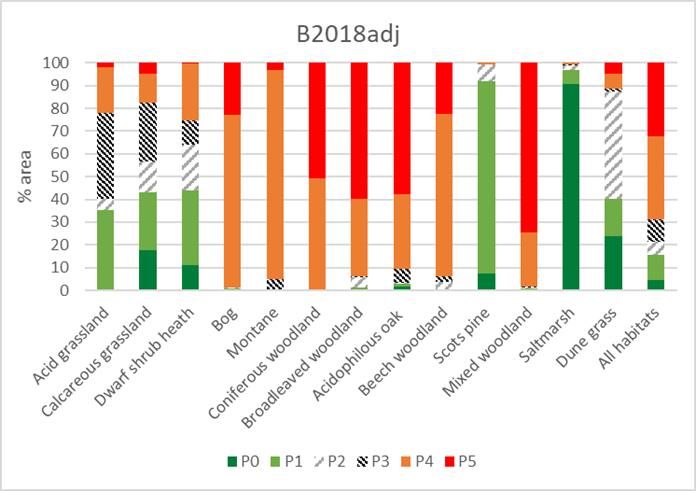Health Impacts
With the main purpose of the UKIAM framework being to assess the impacts of abatement measures to reduce air pollutant and/or greenhouse gas emissions, the mapped air pollutant concentrations provide the basis to derive the total cumulative air quality benefits. Air quality benefits include reduced damage to health, productivity, ecosystems and soiling of buildings. Benefits may be associated with reductions in PM2.5 exposure and other pollutants such as NO2 and quantified using guidance provided by COMEAP (the UK’s Committee on the Medical Effects of Air Pollutants) and the WHO.
For most abatement measures there is both a capital cost and operating cost. For the purposes of comparison, the equivalent annualised cost of measures may be calculated by distributing capital costs over the lifetime of the measure and combining with operational expenditure. This allows for a representative cost per year of the measures to be compared where lifetimes of costs differ. Setting the monetised benefits against the social costs summary appraisal statistics can be derived such as the Net Present Social Value and Benefit Cost Ratio, which provide an indication of the net economic impact of the modelled scenarios.
Mean population exposure is generally used to quantify health impacts and monetised benefits of pollution abatement, alongside exposure-response functions, population data and economic inputs. However, there are also equity issues and concerns about higher PM2.5 concentrations coinciding with more deprived members of society. Ongoing research uses the Index of Multiple Deprivation (IMD) to explore correlations between higher exposures and higher levels of deprivation. This is becoming a more significant issue as we move into the future with, for example, electrification of road transport potentially changing the exposure inequality. The UKIAM is well placed as a tool for this purpose due to its capability to generate full source apportionment for concentration reductions.
Relevant Publications
- Porwisiak, P., Werner, M., Kryza, M., Vieno, M., Holland, M., ApSimon, H., Drzeniecka-Osiadacz, A., Skotak, K., Gawuc, L. and Szymankiewicz, K. (2023) Modelling of benzo(a)pyrene concentrations for different meteorological conditions – analysis of impacts on lung cancer and economic costs, Environment International, 173. https://doi.org/10.1016/j.envint.2023.107863.
- Klimont, Z., Kiesewetter, G., Kaltenegger, K., Wagner, F., Kim, Y., Rafaj, P, Schindlbacher, S., Heyes, C., Denby, B., Holland, M., Borken-Kleefeld, J., Purohit, P., Fagerli, H., Vandyck, T., Warnecke, L., Nyiri, A., Simpson, D., Gomez-Sanabria, A., Maas, R., Winiwarter, W., Ntzachristos, L, Georgakaki, M., Bleeker, A., Wind, P., Hoglund,-Isaksson, L., Sander, R., Nguyen, B., Poupa, S. and Anderl, M. (2022) Support to the Development of the Third Clean Air Outlook. European Commission DG Environment. https://circabc.europa.eu/ui/group/cd69a4b9-1a68-4d6c-9c48-77c0399f225d/library/4f014b48-eb5a-417c-88f2-abe6bb0abdc3/details, and https://circabc.europa.eu/ui/group/cd69a4b9-1a68-4d6c-9c48-77c0399f225d/library/04023caa-eee9-4ec3-9200-b9e9b40183ce/details
- Birchby, D., Conlan, B., Menadue, H., Alvarez, M., Wingard, E., Southgate, J., Dubey, J., Klimont, Z., Kiesewetter, G., Denby-Rolstad, B., Janoska, P, Artola, I., Forestier, O., Cihlarova, P., Williams, R., Janssen, S., Hooyberghs, H., Holland, M., Vandyck, T. (2022) Study to support the impact assessment for a revision of the EU Ambient Air Quality Directives. Specific Contract under Framework Contract ENV/F1/FRA/2019/0001. For European Commission, DG Environment.
- Baojing Gu, Lin Zhang, Rita Van Dingenen, Massimo Vieno, Hans JM Van Grinsven, Xiuming Zhang, Shaohui Zhang, Youfan Chen, Sitong Wang, Chenchen Ren, Shilpa Rao, Mike Holland, Wilfried Winiwarter, Deli Chen, Jianming Xu and Mark A. Sutton, 2021, Abating ammonia is more cost-effective than nitrogen oxides for mitigating PM2.5 air pollution, Science, 4 Nov 2021, Vol 374, Issue 6568, pp. 758-762, DOI: http://doi.org/10.1126/science.abf8623
- Holland, M. (2019) Cost-Benefit Analysis and Air Quality Related Health Impacts: A European Perspective. Encyclopaedia of Environmental Health, Second Edition, 755-766. Elsevier.
- Royal College of Physicians. Every breath we take: the lifelong impact of air pollution. Report of a working party. London: RCP, 2016. https://www.rcplondon.ac.uk/projects/outputs/every-breath-we-take-lifelong-impact-air-pollution
- Reis, S., Voigt, K. & Oxley, T., 2017, Thematic issue on modelling human and ecological health risks: Editorial, Environmental Modelling & Software, 93, pp 106-108, https://doi.org/10.1016/j.envsoft.2017.02.029
- Oxley, T., ApSimon, H. & A. de Nazelle, 2015, Investigating potential health benefits of focussed PM2.5 emission abatement strategies in London, Environmental Modelling & Software, 74, pp 268-283, https://doi.org/10.1016/j.envsoft.2015.07.011
- Smith, A., Holland, M., Korkeala, O., Warmington, J., Forster, D., ApSimon, H., Oxley, T., Dickens, R. & S. Smith, 2015, Health and environmental co-benefits and conflicts of actions to meet UK carbon targets, Climate Policy, https://doi.org/10.1080/14693062.2014.980212
- Holland, M., Spadaro, J.V., Misra, A., Pearson, B., Fagerli, H., Simpson, D., Nyiri, A., Heyes, C., & Oxley, T., 2014, Costs of air pollution from European industrial facilities 2008-2012 – an updated assessment, EEA Technical Report, No 20/2014, ISBN 978-92-9213-495-2, ISSN 1725-2237, https://data.europa.eu/doi/10.2800/23502
Economic Impacts, Co-benefits and Trade-offs
Policy support frequently requires quantification of economic impacts of policies to identify the most economically efficient approach to meeting environmental or other targets, and to assess whether the benefits of actions outweigh the costs. Important tools for this work include cost-effectiveness analysis (CEA) and cost-benefit analysis (CBA).
Monetisation of health and environmental impacts remains controversial in some circles, although it is widely used by national governments and bodies such as OECD and the European Commission. The values used are based on surveys of public preference and hence provide an indication of how members of the public value their health and the world around them. The methods used have consistently shown the benefits of actions on air pollution and climate to outweigh the costs.
It is increasingly important in the development of policies to recognise the presence of co-benefits and trade-offs of actions. These are side effects of actions, that may be beneficial (co-benefits) or adverse impacts (trade-offs). Examples of the former include reduced greenhouse gas emissions, congestion, noise, etc from various actions on traffic, whilst examples of the latter include increased generation of solid wastes from sulphur abatement at power stations. In general, co-benefits of actions have been found to strongly outweigh trade-offs. Understanding of these effects is important in order to design policies that are economically, socially and environmentally optimal.
Relevant Publications
- ApSimon, H., Oxley, T., Woodward, H., Mehlig, D., Dore, A. and Holland, M., 2021, The UK Integrated Assessment Model for source apportionment and air pollution policy applications to PM2.5. Environment International, 153, https://doi.org/10.1016/j.envint.2021.106515.
- Holland, M., 2019, Cost-Benefit Analysis and Air Quality Related Health Impacts: A European Perspective. Encyclopaedia of Environmental Health, Second Edition, 755-766. Elsevier.
- Jones, L., Vieno, M., Fitch, A., Carnell, E., Stedman, C., Cryle, P., Holland, M., Nemitz, E., Morton, D., Hall, J., Mills, G., Dickie, I. and Reis, S., 2019, Developing a Natural Capital Account for air pollution removal by vegetation. Journal of Environmental Economics and Policy. https://doi.org/10.1080/21606544.2019.1597772.
- Williams, M.L., Beevers, S.D., Kitwiroon, N., Dajnak, D., Walton, H., Lott, M.C., Pye, S., Fecht, D., Toledano, M.B. and Holland, M., 2018, The Air Pollution and Health Benefits of the UK Climate Change Act - A Case Study for Great Britain. The Lancet Planetary Health, https://doi.org/10.1016/S2542-5196(18)30067-6.
- Smith, A., Holland, M., Korkeala, O., Warmington, J., Forster, D., ApSimon, H., Oxley, T., Dickens, R. & S. Smith, 2015, Health and environmental co-benefits and conflicts of actions to meet UK carbon targets, Climate Policy, https://doi.org/10.1080/14693062.2014.980212
Environmental Impacts
Air pollution is a driver of habitat loss due to the deposition of pollutants to soils leading to acidification and eutrophication, or due to the direct exposure of plants to harmful concentrations of pollutants. Acidification leads to reduced fertility and nutrient deficiencies and the loss of acid-sensitive species, while eutrophication (i.e. excessive supply of nitrogen) leads to the loss of species less suited to increased nitrogen conditions with knock on effects up the food chain.
While rates of acidification have fallen significantly since the establishment of the UNECE’s Convention on Long-Range Transboundary Air Pollution (CLRTAP) in 1979, largely due to a shift away from sulphur-rich fuels and reductions in NOx emissions from road transport, rates of eutrophication have not seen significant reductions. Ammonia emissions from agriculture is the main driver of eutrophication in the UK and these emissions have remained fairly constant over the last 20 or so years, while large sources of NOx still remain, including the ring of high NOx emissions which surrounds the UK due to international shipping.

Eutrophication is a driver of habitat loss, which in turn leads to loss of biodiversity. We evaluate the likelihood of harm caused by deposited nitrogen onto sensitive habitats by using Critical Loads (CLs). CLs are estimates of the deposition rate of nitrogen below which a habitat is not considered to be significantly harmed, according to current knowledge. These are derived empirically by a team of experts and agreed upon at expert workshops under the CLRTAP. These CLs are used as threshold values to determine whether habitats are under risk from eutrophication or not. In the case that the rate of nitrogen deposition onto a habitat exceeds its CL value, the habitat is considered to be at risk of damage, and potentially the loss of that habitat.
A probabilistic approach was developed within the UKIAM model to evaluate the likelihood of exceedance of their CLs for nitrogen-sensitive habitat areas. This probabilistic approach acknowledges the very large uncertainty that currently exists in the estimates of deposition rates from models and uses a scaling method to provide an upper and lower estimate for deposition. These upper and lower values are then combined with a minimum and maximum CL value to derive an exceedance score, ranging from 0 highly unlikely to be in exceedance, to 5 highly likely to be in exceedance. The figure below illustrates how this scoring is derived.
Applying the CL score to our existing 2018 baseline, we see a wide range of exceedances across different habitats. In the below figure, the green bars indicate the proportion of habitat area likely to be below the CL exceedance, while the red and orange bars indicate the proportion likely in exceedance. The shaded bars indicate marginal cases where there is particularly large uncertainty in the estimate. It’s clear that some habitats are at greater risk than others, with woodlands faring particularly badly. For all habitats (right hand bar), the vast majority of the area is likely in exceedance, highlighting the need for action to reduce ammonia emissions from agriculture in the UK.

Relevant Publications
- Woodward, H., Oxley, T., Rowe, E.C., Dore, A.J., & ApSimon, H., 2022, An exceedance score for the assessment of the impact of nitrogen deposition on habitats in the UK, Environmental Modelling & Software, 150 (2022) 105355, https://doi.org/10.1016/j.envsoft.2022.105355
- Smith, A., Holland, M., Korkeala, O., Warmington, J., Forster, D., ApSimon, H., Oxley, T., Dickens, R. & S. Smith, 2015, Health and environmental co-benefits and conflicts of actions to meet UK carbon targets, Climate Policy, https://doi.org/10.1080/14693062.2014.980212
Reports to Defra
Woodward, H., Oxley, T. & ApSimon, H., 2020, Assessing the impact of nitrogen deposition on sensitive ecosystems in the UK, Report to Defra, SNAPCS Contract ECM-53210, October 2020.
For staff
If you are a new CEP staff member and would like to be included on the research webpages, or would like to amend your existing details, please submit this form (login required- only works for members of CEP).